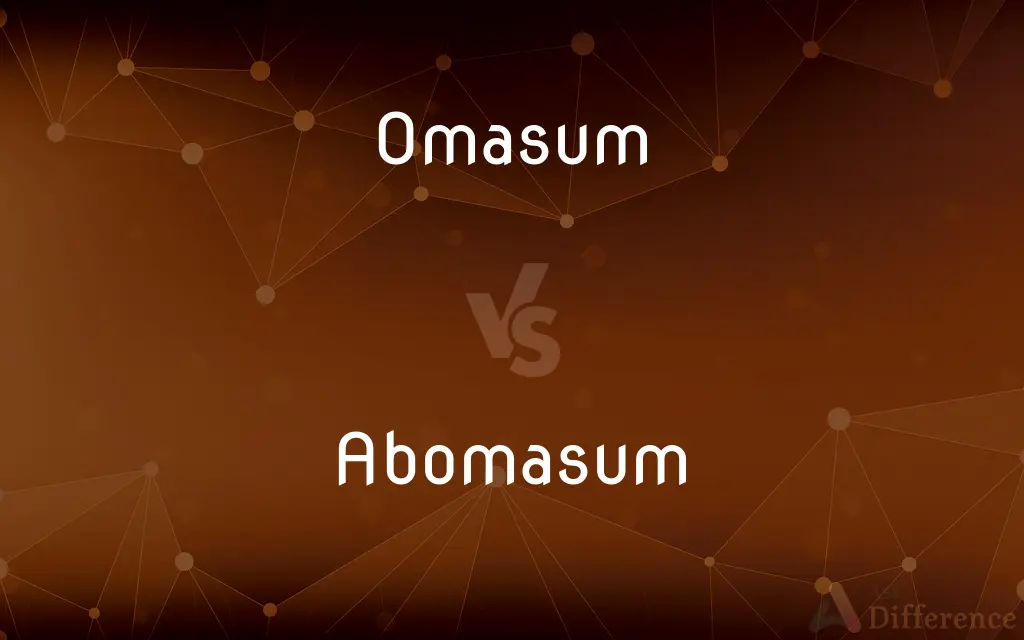Omasum vs. Abomasum — What's the Difference?
By Fiza Rafique & Maham Liaqat — Updated on March 21, 2024
The omasum, part of a ruminant's stomach, focuses on water absorption and particle reduction, whereas the abomasum, often called the "true stomach," is where chemical digestion begins, akin to a human's stomach in function.

Difference Between Omasum and Abomasum
Table of Contents
ADVERTISEMENT
Key Differences
The omasum is the third compartment of a ruminant's stomach, playing a crucial role in the digestive process by absorbing water and further breaking down food particles after they leave the rumen and reticulum. On the other hand, the abomasum is the fourth and final compartment, where the digestive process resembles that of monogastric animals like humans, involving the secretion of digestive enzymes and acids to break down nutrients chemically.
While the omasum's primary function is to reduce the particle size of the digesta and absorb water and some volatile fatty acids, thereby concentrating the digesta before it enters the abomasum, the abomasum focuses on the enzymatic digestion of proteins. The environment in the abomasum is acidic, which aids in the breakdown of proteins and prepares the digesta for nutrient absorption in the intestines.
The lining of the omasum contains many folds, known as laminae, which increase the surface area for absorption and mechanical digestion. In contrast, the abomasum's lining is smoother and is equipped with glands that secrete gastric juices, including hydrochloric acid and digestive enzymes. This structural difference highlights their distinct roles in digestion.
Feed moves through the omasum at a slower rate than through the other stomach compartments, allowing for extensive water absorption. This slow movement contrasts with the more rapid passage of digesta through the abomasum, where the primary focus is on chemical digestion rather than absorption.
The efficiency of the omasum in water and nutrient absorption plays a vital role in the overall hydration and nutrient utilization of the animal. Conversely, the abomasum's efficiency in breaking down proteins and activating enzymes is crucial for the animal's ability to assimilate amino acids and other nutrients essential for growth and health.
ADVERTISEMENT
Comparison Chart
Function
Water absorption, particle reduction
Chemical digestion of food
Position
Third compartment
Fourth (final) compartment
Digestive Process
Mechanical digestion
Chemical digestion
Lining
Contains many folds (laminae)
Smoother with digestive glands
Main Digestive Role
Concentrates digesta through absorption
Breaks down proteins with acids and enzymes
Compare with Definitions
Omasum
An intermediary stage in the ruminant digestive process, focusing on absorption.
The omasum plays a key role in the animal's hydration.
Abomasum
Specialized for the enzymatic breakdown of nutrients.
Gastric juices in the abomasum are essential for digesting complex proteins.
Omasum
Characterized by numerous folds that maximize surface area for digestion.
The omasum's structure is uniquely adapted for its function.
Abomasum
Known as the "true stomach" of ruminants, where chemical digestion begins.
The abomasum secretes acids and enzymes for protein digestion.
Omasum
A stomach chamber in ruminants for water absorption and food particle reduction.
The omasum's folds increase its efficiency in absorbing water.
Abomasum
Features a smoother lining with glands for secretion of digestive juices.
The abomasum's design is optimized for chemical digestion.
Omasum
The third compartment of a ruminant's stomach, crucial for mechanical digestion.
Feed particles become smaller as they pass through the omasum.
Abomasum
Plays a critical role in preparing digesta for nutrient absorption in the intestines.
Efficient digestion in the abomasum is vital for animal health.
Omasum
Essential for the concentration of digesta before chemical digestion.
Without the omasum's function, nutrient absorption would be less efficient.
Abomasum
The final stomach compartment, analogous to a human's stomach.
The abomasum completes the digestive process started in earlier chambers.
Omasum
The omasum, also known as the bible, the fardel, the manyplies and the psalterium, is the third compartment of the stomach in ruminants. The omasum comes after the rumen and reticulum and before the abomasum.
Abomasum
The abomasum, also known as the maw, rennet-bag, or reed tripe, is the fourth and final stomach compartment in ruminants. It secretes rennet, which is used in cheese creation.
Omasum
The third division of the stomach of a ruminant animal, located between the abomasum and the reticulum. Also called manyplies.
Abomasum
The fourth division of the stomach in ruminant animals, such as cows, sheep, and deer, in which digestion takes place.
Omasum
The third compartment of the stomach of a ruminant; the lining of said compartment, regarded as a foodstuff.
Abomasum
The fourth or digestive compartment of the stomach of a cow or other ruminant, after the omasum;
the lining of said compartment, considered as a foodstuff.
the lining of said compartment, considered as a foodstuff.
Omasum
The third division of the stomach of ruminants. See Manyplies, and Illust. under Ruminant.
Abomasum
The fourth or digestive stomach of a ruminant, which leads from the third stomach omasum. See Ruminantia.
Omasum
The third compartment of the stomach of a ruminant
Abomasum
The fourth compartment of the stomach of a ruminant; the one where digestion takes place
Common Curiosities
Can the functions of the omasum and abomasum be compared to any part of the human digestive system?
The abomasum is comparable to the human stomach in its role in chemical digestion.
How does the abomasum differ from the omasum in function?
The abomasum is responsible for the chemical digestion of food, using acids and enzymes.
What role does the abomasum play in nutrient absorption?
It breaks down proteins into absorbable forms, facilitating nutrient absorption in the intestines.
Why does the omasum have many folds?
To increase the surface area for effective water absorption and mechanical digestion.
What is unique about the abomasum's lining?
It contains glands that secrete gastric juices, including hydrochloric acid and digestive enzymes.
What is the primary function of the omasum?
To absorb water and further reduce food particle size, concentrating the digesta.
Why is the omasum important in the digestive process of ruminants?
It plays a critical role in water absorption and mechanical digestion, preparing digesta for chemical digestion.
How does food move from the omasum to the abomasum?
After sufficient water absorption and particle reduction in the omasum, food moves to the abomasum for chemical digestion.
What happens to proteins in the abomasum?
Proteins are broken down into peptides and amino acids by digestive enzymes and acid.
Is the omasum solely responsible for water absorption in ruminants?
While not solely responsible, it plays a significant role in the overall hydration and concentration of digesta.
Why is the abomasum called the "true stomach"?
Because its function—chemical digestion with acids and enzymes—most closely resembles the stomach of non-ruminant animals.
How does the structure of the omasum aid in its function?
Its many folds increase surface area for more efficient absorption and digestion.
How does the digestion process in ruminants differ from that in monogastric animals?
Ruminants have a complex stomach with multiple compartments for mechanical and chemical digestion, unlike monogastrics with a single stomach.
What types of enzymes are secreted by the abomasum?
It secretes proteases for protein digestion, among other enzymes.
What is the significance of the abomasum's acidic environment?
The acidity activates enzymes and helps break down proteins into absorbable molecules.
Share Your Discovery

Previous Comparison
Whooping vs. Whopping
Next Comparison
Barbecue vs. TandoorAuthor Spotlight
Written by
Fiza RafiqueFiza Rafique is a skilled content writer at AskDifference.com, where she meticulously refines and enhances written pieces. Drawing from her vast editorial expertise, Fiza ensures clarity, accuracy, and precision in every article. Passionate about language, she continually seeks to elevate the quality of content for readers worldwide.
Co-written by
Maham Liaqat














































